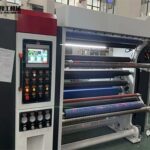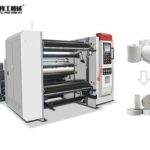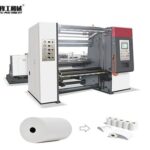Film slitting machine, also known as a slitter rewinder or slitter, is engineered to cut wide parent rolls of flexible materials into narrower strips while maintaining consistent quality and dimensional accuracy. Common materials processed include polyethylene (PE), polypropylene (PP), polyethylene terephthalate (PET), biaxially-oriented polypropylene (BOPP), and metallized films. The primary objective is to produce smaller rolls that align with specific end-use requirements, whether for consumer packaging, electronic components, or agricultural films. Unlike standard cutting devices, slitting machines incorporate advanced tension control systems and precision-cutting mechanisms to ensure minimal waste and optimal edge quality.
Features of Film Slitting Machine
- High Precision Cutting
Equipped with advanced blade systems and tension control, these machines achieve precise width tolerances. - Versatile Material Compatibility
Suitable for slitting BOPP, PET, PVC, CPP, PE, paper, and even aluminum foil laminates. - Automatic Tension and Edge Control
Ensures consistent film feed and reduces manual intervention. - Touch Screen Control and Data Storage
Modern interfaces make operation intuitive and allow for saving multiple job settings. - Energy Efficiency and Safety Design
Low energy consumption motors, safety covers, and emergency stops ensure both efficiency and operator safety. - Low Noise and Stable Performance
Precision components and shock-absorbing structures minimize vibration and noise.
Structure and Components
A typical film slitting machine consists of several main components that work together to ensure smooth operation and high accuracy:
- Unwinding Unit
The unwinding section holds the large mother roll of film. It ensures smooth feeding into the machine with constant tension control to prevent wrinkles or film stretching. - Slitting Section
This is the heart of the machine. It contains blades or rotary knives that perform the actual cutting. The arrangement of knives can be shear type, razor type, or score type, depending on the material and desired precision. - Rewinding Unit
After cutting, the narrower strips are wound onto new cores to form finished rolls. The rewinding section maintains even tension and alignment to produce neat and compact rolls. - Tension Control System
Maintaining proper tension is critical for film slitting. Automatic tension controllers adjust torque and speed to ensure consistent film feed, avoiding loose or overly tight rolls. - Transmission System
The power is transmitted from the motor to the rollers and blades. Servo motors are commonly used for high-speed and precise synchronization. - Control Panel
Modern machines come with touch-screen interfaces and PLC (Programmable Logic Controller) systems that allow easy setting of parameters such as speed, width, and tension. - Waste Collection System
Trim waste or edge cuttings are collected and wound separately, helping maintain a clean production environment.
Applications of Automatic Film Slitting Equipment
Film slitting machines are used across a wide range of industries:
- Packaging Industry: For converting plastic films into rolls suitable for food, pharmaceutical, and consumer goods packaging.
- Printing Industry: To prepare printing substrates like PET or BOPP films in precise widths.
- Electronics: For cutting insulation and protective films used in display screens or circuits.
- Label Manufacturing: To slit adhesive or label stock materials into roll formats.
- Textile and Lamination: To process coated or laminated materials with uniform dimensions.
The versatility of the film slitting machine makes it an indispensable tool for any industry that deals with flexible materials in roll form.




